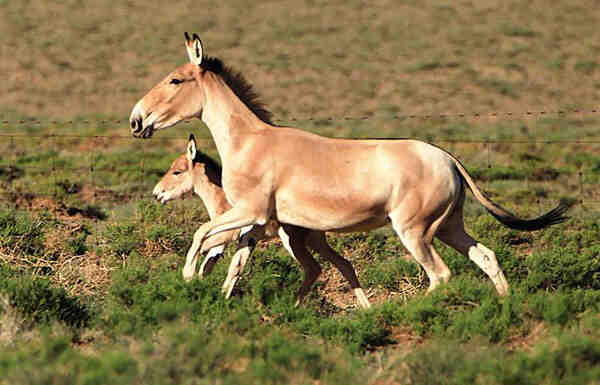Asiatic Wild Ass
IUCN
LCBasic Information
Scientific classification
- name:Asiatic Wild Ass
- Scientific Name:Asian wild ass, wild ass, asian wild ass
- Outline:Ungulata
- Family:Perissodactyla Equine Equus
Vital signs
- length:260cm
- Weight:250kg
- lifetime:30years
Feature
有极强的耐力,警惕性高会掘井
Distribution and Habitat
Distributed in China, India, Islamic Republic of Iran, Mongolia and Turkmenistan.
Regionally extinct: Afghanistan, Armenia, Azerbaijan, Georgia, Iraq, Jordan, Kuwait, Kyrgyzstan, Lebanon, Russian Federation, Syrian Arab Republic, Tajikistan and Turkey.
Occasionally introduced: Israel, Kazakhstan, Saudi Arabia, Ukraine, Uzbekistan.
Lives in desert or semi-desert areas, mostly in the plateau subarctic zone at an altitude of 3000-5000 meters. In summer, it lives in mountains with an altitude of more than 5000 meters, and in winter, it lives in places with lower altitudes. It is a typical desert animal.
Appearance
It looks like a mule, with a body length of up to 260 cm, a shoulder height of about 120 cm, a tail length of about 80 cm, and a weight of about 250 kg. The snout is slightly slender, and the ears are long and pointed. The tail is slender, with long brown hair at the tip. The limbs are strong and powerful, and the hooves are smaller than those of a horse but slightly larger than those of a domestic donkey. The nape of the neck has short bristles, and the back of the neck, shoulders, and back are light yellow-brown. There is a tan back line in the middle of the back that extends to the base of the tail. The neck, chest, sides, and abdomen are yellow-white, with no obvious dividing line from the back hair color.
Details
Mongolian wild ass has the foreign name Asiatic Wild Ass, which has 5 subspecies and is a large ungulate animal.

Mongolian wild ass has the habit of group activities, and female asses, male asses and young asses live together all year round. Each group has 5-8 or 20-30 heads. In summer, in places with good water and grass conditions and little human interference, the Mongolian wild donkey population will be large. The Mongolian wild donkey population living by the Yishakpati Lake in the Altun Mountain Nature Reserve in Xinjiang often has more than 100 to 200 individuals in a large group. In the Hartun Basin area on the northern edge of the Qaidam Basin, it is usually 3-5 individuals that move in small groups, and it is also common to see wild donkeys that move alone.
The Mongolian wild donkey has a whistle donkey, which is extremely vigilant and loyal to its duties. When you get close to it at a distance of 500-600 meters, it starts to run slowly, running and stopping, always keeping a distance of 500-600 meters from people, and finally it lures people to walk in the opposite direction of the donkey herd to ensure the safety of the donkey herd. Donkeys usually have a group of 20 to 200 donkeys. Once a dangerous situation occurs, the leader of the group will lead other members to flee in a straight line, which is very spectacular.
Every August and September, Mongolian wild donkeys enter the breeding and mating period. At this time, the male donkeys become very fierce and neigh frequently. They often fight fiercely for the right to mate. The victorious male wild donkey controls the activities of the entire donkey group. If any donkey is disobedient, it will be kicked and bitten. Mongolian wild donkeys take good care of their young. I have seen a group of wild donkeys crossing a river. When a little donkey couldn't climb up the river bank, two big wild donkeys held it in the middle and pushed the little donkey ashore with their shoulders.
Mongolian wild donkeys have the habit of migrating short distances with the seasons. They usually move regularly, drinking water from the water source in the early morning, eating and resting on the grassland during the day, and returning to the depths of the mountains to spend the night in the evening. They wander dozens of kilometers every day. In places where wild donkeys often move, the undisturbed Mongolian wild donkeys like to line up in a column and move in a line. Near grasslands and water sources, they often walk along a fixed route, leaving a unique "donkey trail" on the grass. The donkey trail is about 20 cm wide and stretches everywhere in a crisscross pattern.
In arid environments, Mongolian wild donkeys will find a suitable place to dig a pit with their hooves to dig out water for drinking, and can also provide drinking water for ungulates such as Tibetan antelopes. When there is drought and water shortage, the clever Mongolian wild donkeys will choose a place with a high groundwater level in the river bend to "dig wells". They use their hooves to dig out a large puddle about half a meter deep on the beach, which local herdsmen call "donkey wells".
Listed in the 2012 Red List of Endangered Species of the World Conservation Union (IUCN) ver3.1 - Endangered (EN).
Listed in the CITES I level protected animals of the Washington Convention.
Listed in the China Red Book: E Endangered level: Endangered.
Listed in the first level of the China National Key Protected Wildlife List.
Protect wild animals and stop eating game.
Maintaining ecological balance is everyone's responsibility!








